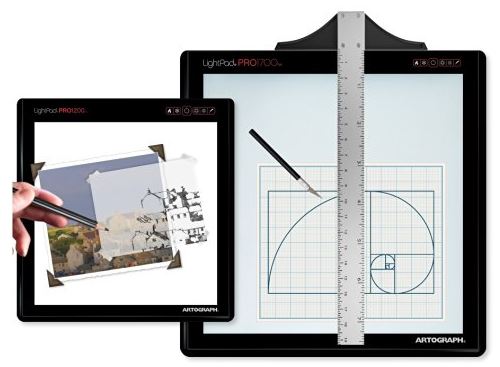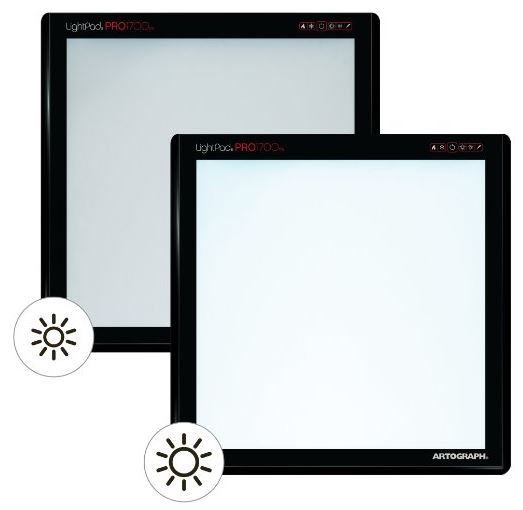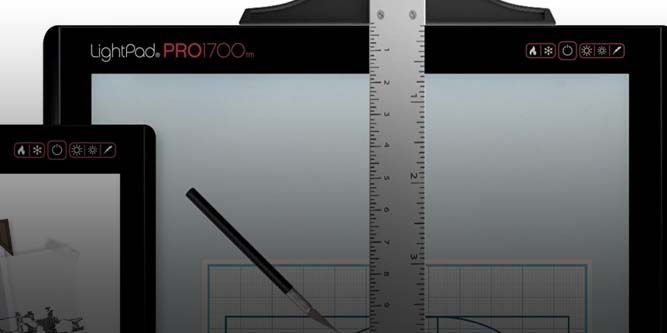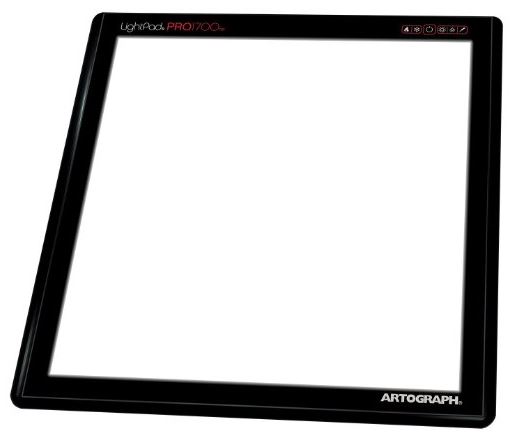Lightboxes are commonly used anytime one needs to manually reproduce an image. Cartoonists spend most of their time working with lightboxes, making sure each frame they draw lines up with the last. Other times, artists may just wish to recreate an element from one of their previous works to integrate it into a new piece. They also play a role in helping us preserve our history. For archival purposes, lightboxes are used to analyze and recreate parts of historical documents that are too fragile or important to put though the harsh environments created in a scanner or photocopier. In education, they can help you ease your way into learning a new format or art style. They have been manufactured in many different shapes and styles to suit each of these individual purposes.
Historically, lightboxes are very large and expensive. With a large amount of equipment required to create flat, even lighting, they were often sold in a table format. As technologies improved, tabletop lightboxes became more commonly available. While they each had their own sets of benefits and drawbacks, you could usually find a model that suited your specific purpose. Art has never been about finding a format and sticking to it. Art is about exploring many different ways to express yourself creatively. Artograph, one of the largest lightbox manufacturers, has been working to create products that were both easy to use and adaptable. With the LightPad Pro 1700, they may have just found the magic formula.
First Look
The LightPad Pro 1700 is a very compact unit. Placing it directly on top of your work area, working with it feels no different than working directly on a table. Ultra-bright LED lighting is filtered, creating an evenly lit surface area. Their no-nonsense design might look fairly simple, but there are many powerful controls available to make this lightbox suitable for any purpose. The face is made to be incredibly durable, constructed from multi-layer tempered glass. With a 17.5” square working area, there are very few applications that Artograph didn’t factor into the design.

History
Artograph has been manufacturing lightboxes and similar products since 1947. According to their website, their motto is “Make it simple and make it easy.” Starting out in the owner’s garage, he created one of the first art projectors on the market. Harvesting scrap plywood, lenses and bellows, his product worked well and became a hit. Artograph went on to become the largest manufacturer of art projectors, later expanding to create spray booths, light boxes, and studio equipment.
Creating art is a very personal and dynamic process. The tools you use have a large impact on how your process develops. Knowing who makes your tools is an important part of the buying process. A lightbox may seem like a simple product to manufacture, but there are many little nuances that can make them either simple or frustrating to use. Artograph’s long history of creating art products is a good indicator that they are familiar with the creative process, and have refined their product lines to a point where they average consumer can enjoy them.

Ergonomics
The comfort of using a lightbox is going to directly impact the quality of your work. The largest complaint is that they are too thick. Try this little experiment: On a sheet of paper, create a little doodle as you normally would. After, try to create the same doodle without allowing your arms to contact the table. It’s challenging, isn’t it? Many lightboxes are quite thick. This forces you to lift your elbows off the table, making it much more challenging to create the careful pen strokes you are used to. Artograph’s LightPad Pro 1700 is only half an inch thick. The corners are smoothly rounded, so using it feels almost like working on a flat surface. It weighs about 10 pounds. While it’s not exactly portable, it stays firmly planted on your work surface. There is no chance of accidentally moving it while you work. The small rubber feet on the back assist with this, adding to the pleasant drawing experience.
There are a few controls on the top right of the LightPad. They are simple to use and adjust, even if you have supplies in your hand. The photos can be a little deceiving, as the pad is much larger in real life then it looks. The working surface area is 17.5” by 17.5”. This allows you to work with even the largest paper stock, while still allowing you to secure it in place.
For many projects, accuracy is key. Just like a drafting table, each side of the LightPad is completely square. This allows you to easily use a t-rule or other drafting supplies, and accurately create precise work.

Light Production
The LightPad can be adjusted for any brightness you would like. Regardless of your other settings, the LightPad can scale between a minimum range of 500 lux and 5500 lux. You also have controls to set the color balance. White light is composed of red, green, and blue lighting. The intensities of each of these colors can be adjusted. You can set the color balance as warm as 3000k, which has a very summery orange hue. You can also set it as low as 6200k, which is comparable to fluorescent indoor lighting, or a cloudy winter day. Neutral white is right in the middle of this range at 4600k. With this white balance, you can get a lot more brightness out of the display. 11,000 lux is the highest possible brightness, although it is likely too intense for most purposes. This is approaching the intensity of commercial lighting.
Why would you need all of these settings? The color balance will help you bring out certain details of the work you are tracking. Photographs will look best in a certain light, so adjusting the color balance will give you a more accurate representation of the photo. Brightness settings are to allow you to work with different material. At 11,000k, even the thickest fabrics and tapestries can be worked with.
The light is generated using ultra-long life, low heat LED lighting. These bulbs have an expected life of 30,000 working hours. Even if used for 4 hours per day, every single day, it would be 20 years before you’d have to replace the LightPad. If you’re working with sensitive or archival documents, there is absolutely no UV light produced by these LEDs. Not only are they safe for your source material, but they’re safe for your eyes too.

Durability
Even though this isn’t one of Artograph’s “professional” products, it’s still made to live a long life. The base is thick and resistant to scratches. The bezel is plastic, but it feels securely mounted to the frame. The actual work surface itself is made from multi-layered tempered glass. There are reports of people doing simple crafts on the surface of the LightPad, using scissors and X-acto knives. Personally, we would be concerned about scratches on the surface of the glass, but it’s unlikely this would damage it too much. On Artograph’s website, they have a video of somebody throwing the product on the floor, then proceeding to jump up and down on it. We truly hope that you don’t become that frustrated with your projects, but this does serve to illustrate that the LightPad should have no problem withstanding the occasional accident.
The only feature we would like to see from the LightPad is the inclusion of disposable tracing sheets. Some manufacturers sell thin paper that can go on top of the surface of their lightboxes. If you’re working with paint supplies that could mark the face of your light box, these sheets will keep you protected. It is possible that sheets are made by a 3rd party that could work. But these devices do not have standard sizes, so it may be tricky to find.
Verdict
Whether you’re a casual artist for full time professional, the Artograph LightPad PRO1700 is a great all-around light box. It’s got features included that allow you to use it for almost any purpose you would like. Because of it’s incredible durability, long lifespan, and advanced features, it is a premium product. Hobbyists who only want to use a lightbox on a rare occasion will probably not be able to get enough value out of it, as it is a little pricier than some. The LightPad is more geared to the consumer who want to get the most out of their tools, and are not willing to compromise on quality. If you’re looking for a lightbox that won’t just do everything, but do everything well, then the Artograph LightPad Pro1700 is the one for you.
Meet Ry, “TechGuru,” a 36-year-old technology enthusiast with a deep passion for tech innovations. With extensive experience, he specializes in gaming hardware and software, and has expertise in gadgets, custom PCs, and audio.
Besides writing about tech and reviewing new products, he enjoys traveling, hiking, and photography. Committed to keeping up with the latest industry trends, he aims to guide readers in making informed tech decisions.



Hi, would you use it for a 7 years old who is constantly drawing? Thanks
Yes! I am sure that your 7 year old will love this.
Is amazon the only one that sells it.. can’t find it on Blick or Jerry’s Artorama..
Yes, I believe so.